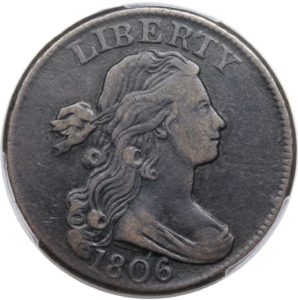Draped Bust Cents (1796-1807)
During the early days of the American coinage, the one cent denomination went through a series of design changes. In a span of 5 years, four different designs were created. It was only when the Draped Bust design was introduced in 1796 that the design reached a measure of satisfaction and was continued in use until 1807.
For this reason, the Draped Bust Cents experienced high mintages during its course. With 3,435,100 pieces minted in 1802, the year marked the highest mintage that occurred during the coin’s lifespan.
highest mintage that occurred during the coin’s lifespan.
The lowest was in 1804 when only 96,500 pieces were minted. With the exception of 1799, where the number of mintage coin was unknown, every year from 1796 to 1807, Draped Bust Cents were struck, resulting in an average yield of 1,460,843 coins per date.
The design of the Draped Bust Cents was made by engraver Robert Scot.
The obverse showed a portrait of a buxom Ms. Liberty, a transformation from a portrait of American painter Gilbert Stuart’s society lady. Some accounts say the lady was Philadelphia socialite Anne Willing Bingham.
Regardless of who was the inspiration behind Ms. Liberty, the design remained essentially unchanged until 1798 when an extra curl was added to her flowing locks.
The reverse of the Draped Bust Cents had three basic designs.
The first one was for the copper coins that featured the coin’s value of half cent or one cent surrounded by a vine or wreath. The wreath is then encircled with the words “UNITED STATES OF AMERICA.”
In 1795 to 1797, all silver coins featured a naturalistic bald eagle and was known as Draped Bust, Small Eagle.
In 1798, after rounds of criticism, the Heraldic eagle replaced the small eagle. From a scrawny looking winged creature, the eagle went through a well-admired transformation. The design became known as Draped Bust, Heraldic Eagle.
The 1804 silver dollar bore the same Heraldic eagle design and that of the 1964 Kennedy half dollar reverse.
To date, many Draped Bust Cents survived but not for every year of mintage. One cents minted in 1799 are considered scarce or rare in all grades because a huge number of these are believed to have been lost at sea. The coins were supposed to be used as payment for slaves but were lost during transit to Africa.
Many 1796 and 1797 pieces exist in Mint State today because Senator Benjamin Goodhue purchased a bag of 1000 cents for his daughters in late 1797 or early 1798. The family preserved the coins for several generations and was sold around 1863 by David Nichols.
There are 1804 cents that exist today that were possibly re-struck by Joseph Mickley around 1860 using dies that were sold by the Mint as scrap metal. Because the dies were rusted and had to be re-tooled, the coins produced were of poor quality. Although these are of interest, they do not carry the same value as the Draped Bust Cents produced at the Mint.
Based in census/population reports, only a few thousand circulation strikes of this coin have been certified, with fewer than 10 pieces representing many varieties.
